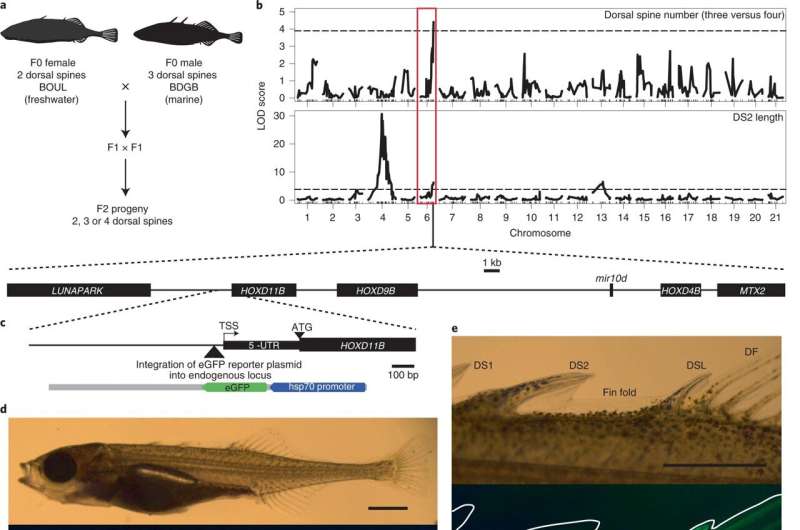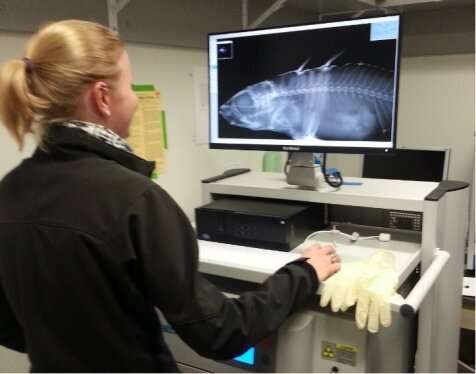Wild fish thrive despite 'hopeless monster' mutations, according to study

A series of experiments led by researchers at Stanford Medicine that included fish hookups, CRISPR and lake hopping has confirmed a long-standing, yet unproven, assumption about natural evolution. It also debunks a talking point favored by proponents of intelligent design, who have argued that naturally occurring mutations will only damage or destroy an animal and can't lead to useful new traits and body structures.
The researchers identified repeated changes in the regulation of a key developmental gene that increase the number and govern the length of the major defensive spines of a fish called the stickleback. New spine traits improve the fish's survival in the face of varying predators—flying in the face of a key assertion by anti-evolutionists that major changes will always leave animals unfit to survive in the wild.
"Scientists already know that changes in the regulation of this gene, called HOX, control the development of major body structures during development," said David Kingsley, Ph.D., professor of developmental biology. "What's new is that we conclusively show that mutations in this gene produce major changes in wild animals—new features that help fish thrive in natural environments. Our findings refute the common argument that these types of genes are so important, so fundamental, that animals with mutations in these regions wouldn't survive in nature—that if you play with master regulators, you're only going to make a hopeless monster."
Kingsley, an HHMI investigator and the Rudy J. and Daphne Donohue Munzer Professor, is the senior author of the research, which was published online Sept. 1 in Nature Ecology and Evolution. Graduate student Julia Wucherpfennig is the lead author of the study.
Although the concept of evolution is widely accepted, it can happen in different ways. Regressive evolution is the loss of existing, previously useful but now disadvantageous or useless traits, resulting in an animal that is more suited to its natural environment. These changes are almost always either neutral—think about cave fish that have lost their eyes after generations in darkness—or helpful, as in early humans' shedding the hairy suit of our ape relatives, enabling us to chase prey for long distances without becoming overheated.
A game of chance
In contrast, progressive evolution occurs when organisms acquire new traits that allow them to outcompete their peers. But such changes are essentially a leap of faith equivalent to rolling the genetic dice and hoping they all come up sixes. Smaller, more gradual changes are less risky. Big structural changes, sometimes called large-effect mutations, can be particularly dicey: Imagine one day you strut out of your apartment sporting a third leg, or two heads. Would you have an advantage over your neighbors when you run for the bus, or are you more likely to trip and fall head(s)-first into traffic?
Although there have been some instances in which animals have gained beneficial traits in nature from changes in HOX genes—fruit flies evolved specific patterns of sensory bristles on their legs and some honeybees gained distinctive coloring on their abdomens—most major structural gains caused by mutations in these regions have been detrimental.

"Laboratory-bred four-winged fruit flies are a famous example of how relatively simple genetic alterations in regulatory regions of the HOX genes can dramatically change the body shape of an animal," Kingsley said. "But because these flies can't survive in the wild, anti-evolution proponents have seized on them—not as good examples of how genes drive evolution, but as proof that gene changes can only make animals less functional."
Two- to four-inch-long stickleback fish, which sport varying numbers of pointy spines along their backs, are great research subjects because they evolve rapidly and dramatically in response to changing environmental conditions. A lake rife with fish-eating insects often houses sticklebacks with fewer and shorter spines to grab. But a pond with larger fish or birds that swallow their fish sticks whole is likely to boast a population of sticklebacks with longer, more numerous, throat-scratching spines. Forests of watery weeds are great for flexible, slippery fish who can hide in the vegetation, while in the open ocean, armored plates and formidable spines are the way to go.
The Kingsley lab started the study with a spot of watery matchmaking. Previous graduate students crossed a two-spined female stickleback from a freshwater lake in British Columbia with a three-spined male stickleback from the salty waters of Bodega Bay, California. They then crossed the progeny from that match with one another and analyzed the number and shape of their spines. Most of the 590 grand-fish had three spines, but six had two spines and 21 had four spines—more than any of their ancestors. Extensive genetic studies of the variably spined fish pinpointed differences in the region around a gene called HOXDB, which is a member of the HOX family of genes.
A link between genes and anatomy
Wucherpfennig continued collecting and crossing sticklebacks from myriad North American lakes and streams, studying their genetic makeup and using CRISPR methods to confirm the effects of the HOXDB gene on dorsal spines. She found a panel of changes in regions near the HOXDB gene and showed they were associated with major anatomical changes that are evolving in the defensive armor of wild fish.
"In Nova Scotia, some of the stickleback populations have evolved to have five or even six spines," Kingsley said. "Nature left the coding region of this gene intact but altered how and when it is expressed during normal development to add structures rather than stripping them away. And fish with these new structures are thriving in a completely wild environment subjected to a whole range of environmental pressures."
Wucherpfennig and her colleagues showed that repeated changes in the regulatory regions of the HOXDB gene are responsible for the recent evolution of new spine patterns in two different stickleback species she studied from across North America. They are now interested in learning whether similar changes are responsible for differences in fish that are even more distantly related.
"Are there predictable rules that govern evolutionary change?" Kingsley said. "Are natural species using the same trick over and over, or do they have to invent a new trick each time? So far, it's been the same gene even in these very divergent sticklebacks from different environments. Here we show that nature routinely adds major structures to generate animals that are more suited to the environment, and that it does so repeatedly using the same master regulatory gene. It's a decisive argument for progressive evolution, which has been debated in academic and non-academic circles for decades."
More information: Julia I. Wucherpfennig et al, Evolution of stickleback spines through independent cis-regulatory changes at HOXDB, Nature Ecology & Evolution (2022). DOI: 10.1038/s41559-022-01855-3
Journal information: Nature Ecology & Evolution
Provided by Stanford University Medical Center





















